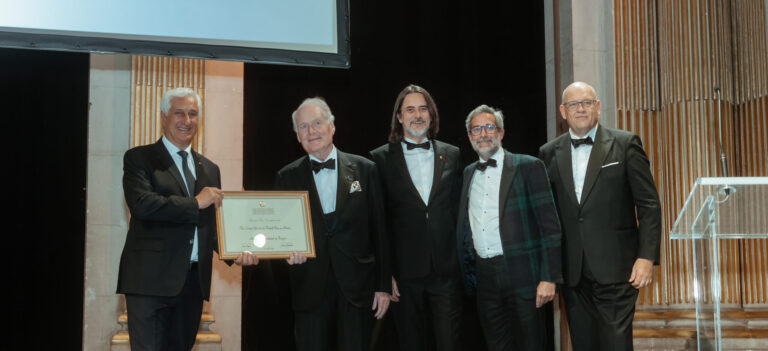Lebanon

Lebanese Academy of Gastronomy
E-mail: info@gastronomielibanaise.org
The Lebanese Academy of Gastronomy (ALG) is a non-profit organization headquartered at the Al Bustan Hotel in Beit Mery. It was founded in 1995 by Mrs. Myrna Bustani, Sheikh Fouad el Khazen, and the late Dr. Lucien Dahdah (first president), Professor Béchir Saadé, and Professor Edwin Abella.
Since 1996, the ALG has been affiliated with the International Academy of Gastronomy (AIG).
Missions and Objectives:
- Promote Lebanese gastronomy and safeguard traditional Lebanese culinary heritage.
- Promoting Lebanon through its cuisine.
- Support any activity that promotes “eating and drinking well”.
- Promote quality cuisine while respecting local products.
- Encourage the establishment of creative Lebanese cuisine.
- To introduce the dishes of different Lebanese regions.
- To make Lebanon a meeting place between Eastern and Western gastronomy.
- Encourage the publication of books on Lebanese cuisine.
- To showcase Lebanese culinary talents and award them prizes.
The ALG currently has 59 members. It is chaired by Sheikh Fouad el Khazen, and organizes approximately one event per month: dinners prepared by members to benefit the Restos du Cœur, awards ceremonies for renowned chefs or young chefs of the future, competitions between majors from the hotel management faculties of various Lebanese universities, excursions in Lebanon and trips abroad…
A little history…
The mixing of cultures and numerous foreign occupations have largely contributed to forging Lebanon’s cultural and culinary identity.
Lebanon is one of the countries of the Levant. Its name comes from the word ” lubnan,” which is the name of a river of milk in paradise, and which was given to it in reference to the snow-capped peaks of Mount Lebanon.
The Mediterranean, the cradle of the three monotheistic religions, is rich in cultural and culinary exchanges. The Phoenicians were the first to open trading posts in the Mediterranean. The best known is Carthage, founded by Elissar, Queen of Tyre, in 814 BC.
The trading posts were used to export jars of olive oil, murex dye wines, as well as silk and cedar resin.
Until its independence in November 1943, the country was under the domination of several major foreign powers, which left their mark more or less on it with their presence: the Persians, the Assyrians, the Greeks (Macedonians), the Romans, the Byzantine Greeks, the Arabs, the Crusaders, the Mamluks, the Ottoman Empire, and France.
Lebanese cuisine
The Lebanese have a unique way of welcoming visitors, serving them with the authority to restore them. “El Akl Add el Mahabbé,” goes a Lebanese saying (affection is measured by the amount of food one has eaten).
Lebanese gastronomy is at the heart of everyday life. It’s around large tables that business is done and families gather on Sundays.
There are two distinct Lebanese cuisines: the rich and varied coastal cuisine and the simpler mountain cuisine, closer to the land.
Originally, Lebanese cuisine was primarily a cuisine of necessity; many dishes were served without meat, with pulses and dairy products being the basis of many dishes.
Lebanon’s climate is mild, with balanced seasons and lush vegetation. The Bekaa Valley was long considered the Roman Empire’s breadbasket. Bourghoul—crushed wheat—became a staple food long before the importation of rice, with meat usually consumed only during festive events and celebrations.
Until recently, the bulk of Lebanese cuisine revolved around wheat, seasonal vegetables, dairy products, olives, and carob and grape molasses as sugar.
Preserving all these riches that nature offered in abundance encouraged the Lebanese to create the “Moune.” The feast of the Exaltation of the Cross on September 14 marks the beginning of this preparation.
Mouné is a group of local products intended for consumption during the winter. The methods and recipes are generally passed down from generation to generation:
- Awarma, candied meat (a type of rillettes), met the needs of the entire household during the harsh winter months. The slaughter took place on a village feast day. The pieces of meat were salted and drained for several hours, then cooked in their own fat and preserved in earthenware pots to retain their flavor.
- Olive oil remains a staple of Lebanese cuisine. Harvesting takes place after the first autumn rain.
- Kichk is obtained by fermenting bourghoul (crushed wheat) and one or more milk derivatives. It is used in the preparation of soup, man’ouché or even stews.
- The fruits are dried in the sun, or made into jams and syrups
- Debs (molasses) made from grapes or carob trees were used as sugar.
- Reb el Banadoura (tomato paste) is used to prepare many dishes.
Lebanese home cooking is very different from that offered in restaurants, which primarily serve mezze. Mezze serves a social function of friendship and conviviality.
Different meals in Lebanon
Breakfast is one of the most varied in the world:
- Labne (white cheese), cheeses (halloum, baladi, akkaoui, kashkaval, ambaris, etc.)
- Green and black olives, tomatoes, cucumbers, snake cucumbers or me’teh, onions, mint
- Zaatar (thyme preparation) and olive oil
- Foul (beans) and balila (chickpeas)
- Fried eggs, eggs awara (stewed meat)
- Man’ouché with zaatar, jebné (cheese), kichk
- Kichk bi toum (with garlic)
- Debs bi tehiné, Halawa
- Ochta bi Aassal (milk cream with honey)
- Knéfé bi jeben
- Sahlab and kaak
- Green and red figs
- Jams
On the way to school or work, it’s common to eat a thyme man’ouché, a kind of pizza. Thyme, or za’atar, is a mixture of dried oregano, sesame seeds, sumac, and salt. The mixture is tossed with vegetable oil. It’s said to stimulate the neurons.
Schoolchildren take a slice of labneh, zaatar or halloumi (hard white cheese) to school.
Lunch is relatively substantial, as it is usually eaten after 2 p.m. and is considered the main meal of the day. The starter might be a salad (tabbouleh or fattoush), dandelion greens cooked with browned onions, or fried cauliflower with tahini (sesame cream).
As for the main dishes, there are many:
- The most classic meal is a stew with minced meat (beef or mutton, or a mixture of both), an onion, tomato puree, and a pinch of 7 spices. There are a multitude of stews: potato, green beans, white beans, Greek horns, or even peas and carrots. They are accompanied by vermicelli rice.
- Moujadara, a lentil puree, or moudardara, cooked lentils mixed with browned onion, are two “poor man’s” dishes served with white cabbage salad. Lentil and chard soup is a lemony dish popular in winter.
- Kebbe bil-saniyé is a great classic of family cooking. Kebbe is made from beef or mutton processed in a food processor, mixed with bourghoul, onion and a pinch of 7 spices. The meat is spread in a baking dish in two layers, between which is spread a mixture of browned onions with pine nuts and ground beef. The top is cut into diamonds and sometimes squares to allow the oil to penetrate and cook the inside of the meat.
- Kafta (minced beef and lamb mixed with parsley, onions, and a pinch of 7 spices) is served with fries and salad. Kafta is cooked in a pan or spread in an aluminum pan with potatoes, onions, and tomatoes.
- Stuffed vegetables are a great classic: stuffed zucchini, stuffed eggplant or vine leaves… The same goes for dishes with laban (Lebanese yogurt) such as chich barak which is a pastry stuffed with meat, which is dipped in laban flavored with mint and garlic.
In both cities and the countryside, dinner is light. It is often cold and consists of hard cheeses, labneh (Lebanese white cheese), olives, za’atar with olive oil. It is a simple assortment of dairy products, sometimes wrapped in Lebanese bread, and served with soup. It may also consist of steak and fries.
What to drink in Lebanon…
Arak , or “milk of the brave” – the nickname for arak in Zahle – is the essential accompaniment to any self-respecting mezze. It is a drink inseparable from the Bekaa Valley, where it is said to have originated in its current form. White grapes and anise are its two basic ingredients.
Wine was an essential alcohol in the Lebanese terroir, its production dating back to the Phoenician period. From the mid-18th century until the end of the Ottoman occupation, Christian clergy negotiated with the Sublime Porte (Ottomans) for the right to produce wine for their community’s consumption and for Church rituals. The Ottomans were relatively lenient regarding the consumption of this alcohol, producing raki, a close cousin of arak, themselves.
From the beginning of the French mandate and the deployment of French soldiers in the Bekaa Valley, wine began to experience considerable growth, thanks in particular to the French craze for this nectar.
Currently, Lebanon produces 8.5 million bottles of wine per year. This includes red, white, rosé, and sweet wines.
Beer is one of the oldest alcoholic beverages produced by humans. Beer originated in the Near East, as evidenced by certain inscriptions in Egypt and Mesopotamia dating back to the 5th millennium BC. In Iran, archaeologists have unearthed jars dating back 7,000 years containing traces of fermented liquid. Beer is undoubtedly the first product resulting from a biological fermentation process.
“A coffee? Ahwé?” : Every occasion is good in Lebanon to share a coffee. There is no business negotiation, no happy announcement, no discussion that doesn’t take place over coffee. From morning to night, and wherever you are, a cup of coffee is always ready to be served. Historically, it was served in a small, round coffee cup (without a handle). The coffee must be boiled at least three times in a “rakwé.”
After drinking, coffee grounds remain at the bottom of the cup. The cup is then turned upside down, and a fortune teller can predict the future based on the traces left in the cup.
“White Coffee” is a mixture of orange blossom water and hot water. It is usually served at the end of the meal.
The essentials of Lebanese cuisine
If you go to a Lebanese restaurant, we recommend ordering the following dishes:
- Homos
- Moutabbal
- Tabbouleh or Fattouch (the other Lebanese salad)
- Labne (white cheese)
- Kebbe (stuffed meatballs)
- Samboussek bi lahmé (meat bites)
- Samboussek bi jebné (cheese bites)
- Lebanese kebabs: kafta, chich taouk (chicken), lahm michoué (meat)
- Mutton chops
For dessert:
- Mhallabié
- Atayef bi joz (with nuts)
- Atayef bi achta (with milk cream)
Some recipes
Tabbouleh
Authentic Lebanese tabbouleh is made primarily from parsley, tomatoes, onions, mint, and bourghoul (crushed wheat) tossed with lemon juice and olive oil. It is an essential part of every mezze.
It is often served in a tender lettuce leaf, which acts as a spoon. Tabbouleh takes a long time to prepare, as the parsley must be chopped by hand.
Originally, tabal was a meatless stuffing mixture that was put on vegetables and was prepared by women, who, to ensure seasoning, took a bite of tender leaves (lettuce, cabbage or vine leaves). What was left of the stuffing was improved by adding vegetables from the garden (parsley, tomatoes, mint, onion, lemon juice, olive oil…) all of which today constitute the vegetables of Tabbouleh.
Ingredients
- 6 bunches of flat-leaf parsley
- 1 bunch of mint
- 3 green onions
- 2 large tomatoes
- ½ glass of borghoul
- Olive oil
- Salt
- Pepper
Method
- Wash all the vegetables.
- Soak the bourghoul for 15 minutes (some people like it hard and don’t soak it)
- Chop the parsley, strip and chop the mint, finely chop the green onion (if you don’t have green onion, use white onion by crushing it with salt and pepper), cut the tomatoes into small cubes.
- Before serving, mix everything together, seasoning it to taste with oil, lemon, salt and pepper.
Tabbouleh is eaten with lettuce, cabbage leaves or young, tender vine leaves.
Hommos or Hommos bi Tehiné
Hommos means chickpea in Arabic. The first records of the dish date back to the 7th century BC in Mesopotamia . The modern form of hummus is believed to have appeared in the Ottoman Empire during the 15th century . The origin of “Hommos bi Tehiné”, known as “Hommos”, is claimed by Lebanon. The country of origin of hummus is unknown, but the “hummus war” is regularly reported in the press. A documentary is also dedicated to it.
Ingredients:
- 400g dried chickpeas
- 1 to 2 cloves of garlic, peeled (optional)
- Salt
- 6 tbsp tahini (sesame cream)
- Juice of 2 lemons (about 8 tbsp)
- Olive oil for garnish
Method:
- Soak the chickpeas 12 hours in advance in water with 2 spoonfuls of bicarbonate.
- The next day, remove them, wash them and put them in a pot with 4 times their volume of water.
- Cook over high heat, and once boiling, reduce the heat and cook over low heat for about 1.5 hours (until the seeds are tender).
- Pour the tahini and lemon juice into a bowl and mix with a fork. Add water if necessary to obtain a smooth mixture known as Tarator.
- Peel the garlic and blend it with 1 teaspoon of salt in a food processor. Add the cooked chickpeas while still warm and blend until creamy.
- Stir in the Tarator. Dilute with a little chickpea cooking water if necessary.
- Taste and add salt or lemon if necessary.
For a more refined hummus:
After cooking the chickpeas, fry them in a pan with 2 teaspoons of baking soda until the peels come off. Then throw them into a bowl of water: the peels float and the chickpeas stay at the bottom.
This hummus with peeled chickpeas is more refined and more pleasing to the eye.
Oriental rice
(with oriental chicken)
Oriental rice is a popular accompaniment to festive meals. Flavorful and spicy, it can be served with chicken, turkey, beef, or mutton.
For the oriental chicken:
- 1 chicken
- 1 lemon cut in 2
- Sweet pepper, Black pepper, 7 spices, Cinnamon, Salt, 1 cinnamon stick, 1 bay leaf
- 1 onion
- 2 tbsp oil
For the oriental rice:
- 4 tbsp oil
- 400 g of minced meat
- 1 onion
- Sweet pepper, Black pepper, 7 spices, Cinnamon, Salt
- 2 cups (400 g) of short grain Italian rice
- 6 glasses of chicken broth
- 100 g pine nuts
- 50 g of blanched almonds
For the sauce:
- Chicken broth
- Thickening
- 1 tbsp lemon
Prepare the chicken :
- Clean the chicken by rubbing it with lemon and salt inside and out, then wash it in cold water.
- Peel the onion and cut it into 4.
- Brush the chicken with the spices: black pepper, sweet pepper, 7 spices, cinnamon and salt
- In a pot, heat 2 tbsp of oil and brown the chicken and onion on all sides for 5 to 10 minutes. Cover with water and bring to a boil over high heat. Skim off any excess foam if necessary.
- Add the cinnamon stick and bay leaf, reduce the heat, and simmer for about 1.5 hours.
- Turn off the heat, strain the broth through a sieve, and set it aside for cooking the rice.
- Remove the skin from the chicken and bone it, keeping large pieces.
Oriental rice:
- Heat 4 tbsp of oil in a pot and fry the pine nuts until golden.
- Remove them and then brown the almonds.
- Remove the almonds and, in the same pot, brown the onions. When they are tender, add the ground meat with 1/2 tsp. each of sweet pepper, cinnamon, 7 spices, 1/4 tsp. each of black pepper and salt.
- Add 2 ladles of chicken stock to the meat, bring to a boil and simmer for 10 minutes until the liquid has evaporated.
- Then add the washed rice, mix it with the meat and add 4 glasses of chicken broth.
- Cover, bring to a boil, then reduce heat to low and simmer for 10 to 15 minutes until the water has completely evaporated.
Pour the rice into a large serving dish, place the chicken pieces on top and sprinkle with pine nuts and almonds.
For the sauce:
Make a sauce by mixing the cold stock with cornstarch (or other thickener). Heat and add the juice of 1/2 lemon.




